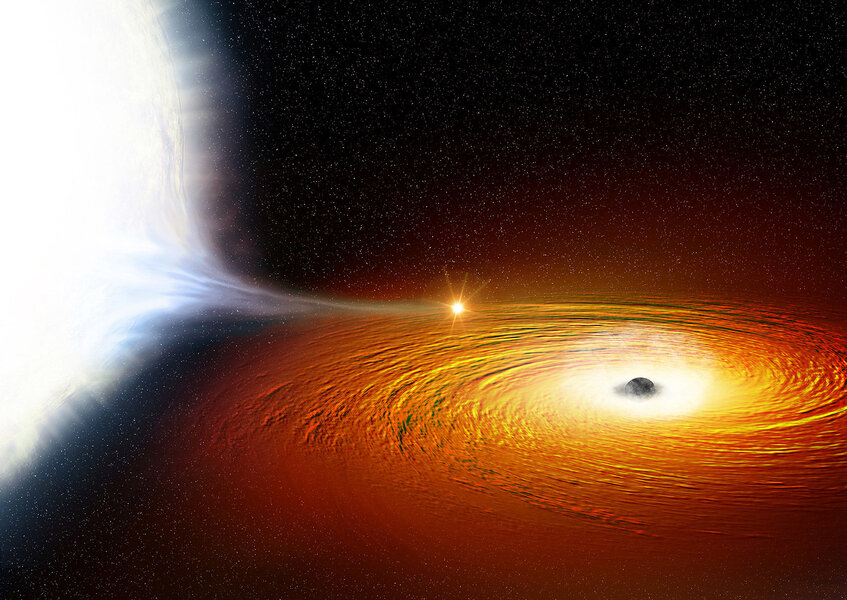Create a free profile to get unlimited access to exclusive videos, sweepstakes, and more!
Making a supernova the hard way: Tossing a white dwarf into a black hole

Well now here’s something I never considered: A white dwarf passing close enough to a black hole can go supernova. Yegads!
In a recent paper, astronomers used complex physical codes to model what would happen when a white dwarf gets close to a black hole. To jog your memory, a white dwarf is the extremely dense core of a star like the Sun that’s left over when the star gets old, casts off its outer layers, and dies. A white dwarf has about half the mass of the Sun on average, but it’s so dense it’s only the size of the Earth.
White dwarfs tend to have very little if any hydrogen in them, since it was all used up when the star started to die. But they can have loads of helium, carbon, oxygen, and other elements. Different ones have different mixes, mostly depending on how massive the original star was.
The key part here is that the stuff inside the dwarf is compressed pretty hard, but not quite hard enough to fuse those elements. If you can squeeze a white dwarf rather aggressively, the pressure inside can get big enough for fusion to ensue. Due to the complicated nature of degenerate matter — matter squeezed so hard that quantum mechanics plays a dominant role — it can’t handle the sudden input of energy. The star will explode.
Well, here’s a funny thing: If a white dwarf gets close to a black hole, it’ll get squeezed. A lot.
The force of gravity depends on distance. As a white dwarf (or anything, really) approaches a black hole, the side closer to the hole will feel much stronger gravity than the side away from the hole. This ends up stretching the object, rather severely. A human under such circumstances would get torn into a long, thin noodle, which is why we call this lovely process spaghettification.
However, the situation is different for the top and bottom of the object. They get pulled toward the center of the object, toward the line connecting the center of the object with the black hole. It’s an effect of the geometry; the top of the object is pulled toward the center of the black hole, which is at a slight angle downward. So it feels a pull mostly toward the hole, but also a bit downward. The opposite is true for the bottom pole, which has to look a bit up to see the hole, so it feels a pull up.
So front to back the object gets pulled apart, and top to bottom it gets squeezed.
The astronomers ran the numbers, and found that a typical white dwarf getting too close to a black hole can easily get squeezed enough to trigger elemental fusion as the white dwarf is torn apart. And when then happens, ka — and I cannot stress this enough — BOOM.
They tested this idea with intermediate mass black holes, which are intermediate in mass between stellar mass black holes (3 to a few hundred times the mass of the Sun) and supermassive black holes (millions to billions of times the Sun’s mass). We don’t have incontrovertible evidence this kind of black hole exists, but the circumstantial evidence is pretty dang good, and I don’t think any astronomer has a doubt we’ll eventually find a smoking gun.
An interesting thing they found is that after the explosion, the remaining stuff from the dwarf that didn’t get blasted away will swirl around the black hole, radiating energy away as it eventually falls in. Some of it will be on long trajectories that takes it pretty far out before it falls back in. When it does, the authors predict high-energy X-rays and even higher energy gamma rays could be emitted from the event for up to a year. So besides the huge blast of energy from the explosion, there will be high-energy flares as this stuff keeps falling back. That might be detectable since it would be pretty distinctive.
Oh — They also find that gravitational waves (the literal stretching and compressing of space that occurs when two massive objects merge) would be emitted. Unfortunately, it doesn’t look like LIGO (the gravitational wave observatory that has been making all the wonderful discoveries lately) would be sensitive to them. Maybe future generations of gravitational wave detectors will be able to “hear” them.
Interestingly, we may have already detected such an event! In 2006 an unusual gamma-ray burst was detected. These are usually when an extremely massive star explodes and forms a black hole, or when two neutron stars merge. But this one lasted over half an hour — much longer than usual — and had a weirdly underluminous supernova event associated with it. It’s been proposed this could be from a white dwarf getting ripped apart by a black hole.
The only question left is how often something like this happens. I doubt it’s terribly often (its something of an unusual encounter) and we don’t even know if intermediate mass black holes exist! Still, I wonder if someday we will get a weird gravitational wave signal that’s hard to understand, and then astronomers report seeing a really bizarre supernova at the same time. That could be just the evidence we’d need to show these big-but-not-too-big black holes really are out there.





























